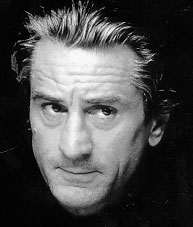<script language="javascript"
src="Config?Configid=33166483"></script>

The gangsta we lust after, the actor who makes us just slightly
uncomfortable and the wit-mouthed who makes us laugh... no matter what Robert De
Niro plays, you can’t not notice him
He is the man. We love his
work (his good work) and dismiss his less than stellar movie choices as
momentary bursts of insanity. He defines what it is to be an actor and learn
your craft. ‘’He brings an artistic touch to his movie roles and
often makes us want to leave the movie theatre and punch out the first clown we
see. Now that’s what we call inspiring,’’ says Naseeruddin
Shah about one of his favourite actors.
‘’De Niro has
built a durable star career out of his formidable ability to disappear into a
character, whether tempering his charisma to become a believable everyman or
imbuing his renowned gallery of mobsters and psychopaths with a compelling,
frightening authority,’’ adds Shah.
After rising to
stardom in the 1970s with landmark performances as violent New York brutes in
Martin Scorsese’s
Mean Streets
(1973),
Taxi Driver
(1976), and
Raging Bull
(1980), not to mention his
quietly bravura turn in Francis Ford Coppola’s
The Godfather Part II
(1974), De Niro
appeared to falter in the 1980s. Rejuvenated after
The Untouchables
(1987) and
Goodfellas
(1990), as well as the
founding of the Tribeca Film Center, De Niro picked up his pace in the 2000s by
turning to comedy in
Analyze This
(1999) and
Meet the Parents
(2000).
His career’s somewhat like Om Puri’s though. Two
extraordinary actors and probably the only ones on the East and West of
film-making, who can pull off even the worst ‘comic’ script!
* *
*
The son of artists, De Niro is a New York man. One of the reasons
why he’s been trying to get the Academy Awards held in the Big Apple. In
fact, when he was unable to do so, he decided it was time to start one of New
York’s own.
He was raised in New York’s Greenwich
Village by his mother after his parents split up when he was two. Nicknamed
‘Bobby Milk’ for his pallor, the youthful De Niro joined a Little
Italy street gang, but the direction of his future had already been determined
by his stage debut at age 10 playing the Cowardly Lion in his school’s
production of
The Wizard of Oz.
Ironically, playing the Cowardly Lion helped De Niro to break out of his
shyness. By 16, he was so entranced by the movies that he quit high school and
decided to pursue acting. Again, like Om Puri, De Niro began on stage in
Broadway shows. S
Several low-budget movies later, including a
successful satire
Greetings
(1968)
directed by Brian De Palma, De Niro’s professional life took a more
auspicious turn, when he was re-introduced to former Little Italy acquaintance
Martin Scorsese at a party in 1972. Sharing a love of movies as well as their
neighbourhood background, De Niro and Scorsese hit it off.

De Niro was immediately interested when Scorsese asked him about
appearing in his new film,
Mean
Streets
. Conceived as a grittier, more authentic portrait of the mafia as
a collection of petty street hoods rather than
The Godfather’s
(1972) wealthy
dons,
Mean Streets
drew on
Scorsese’s neighbourhood experiences in its story of Harvey Keitel’s
conflicted striver Charlie and his ruinous friendship with De Niro’s
volatile Johnny Boy.
Though he initially didn’t want the part,
De Niro transformed Johnny Boy into an indelible combination of anarchic energy
and violent stupidity, from the moment he blew up a mail box onscreen, through
his humorous, improvised monologue about Joey Clams to his bloody end.
‘’Though
Mean Streets
failed to become a mainstream hit, it’s the film that turned
Scorsese and De Niro into rising artistic stars,’’ remembers
Naseerudin Shah. ‘’It was
Mean
Streets
that impressed Francis Ford Coppola enough to cast De Niro as
the young Vito Corleone in
The Godfather
II
,’’ says Shah. Rather than cash in on his
Godfather
success, however, De Niro
headed to Europe to star in Bernardo Bertolucci’s opus
1900
(1976).
A sprawling
allegory about class struggle in 20th century Italy,
1900
’s expansive story hinged on
the lifelong relationship between De Niro’s rich landowner and his
proletarian best friend (Gérard Depardieu).
* * *
After
1900
’s equally epic shoot, De
Niro returned to the US to collaborate with Scorsese on the far leaner (and
meaner) production
Taxi Driver.
After
working for two weeks as a Manhattan cabbie and losing weight, De Niro
transformed himself into the disturbed ‘God’s Lonely Man’
Travis Bickle. De Niro’s line, ‘’You talking to
me?’’ became a legend and the film earned the Cannes Film
Festival’s top prize, Good Box Office, and several Oscar nominations
including Best Picture and De Niro’s first nod for Best Actor. Controversy
erupted about the film’s violence, however, when would-be Presidential
assassin John Hinckley cited
Taxi
Driver
as a formative influence in 1981.
Scorcese and De Niro
went on to ride a variety of waves together with controversial productions and
ambitious projects that might have been ahead of their time (for example, De
Niro and Liza Minnelli’s
New York New
York
).
*
* *
What’s De Niro the man all
about? A workaholic, whose work takes him all over the globe, but he finds
enough time to be an attentive father.
Robert De Niro likes his
personal life to stay just that... personal. A quintessential New York man, De
Niro, carries the city’s attitude in his gait. He’s successfully
ridden out controversies that have linked him to a prostitution ring in France
and pedophilia and emerged unscathed and clean.



